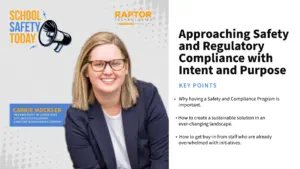The Challenges and Opportunities of the 2022-23 School Year
Dedicated to raising the up-and-coming workforce while tasked with meeting the social, emotional, and physical needs of children, the U.S. educational system is in a constant state of evolution. However, there are many who would say that the system does not evolve fast enough or in a manner that is actually meeting students’ needs for the challenges of the world they are preparing to enter.
And since March of 2020 when Covid took the world by storm, the failings of the U.S. educational system have made headlines over and again. Increasingly, parents are looking for alternative educational methods with homeschooling options on the rise. According to the U.S. Census Bureau, homeschooled students rose from 3% pre-pandemic to 11% in the 2021-22 school year with no sign of numbers returning to pre-pandemic levels any time soon.
Socioeconomic dynamics, inequalities for underserved communities, lack of access to technologies, too much exposure to technologies, too few teachers, lack of resources, and hybrid classrooms are just some of the challenges that drove families to re-evaluate their children’s educational setting.
Dana Bryson, Senior Vice President of Social Impact at Study.com, urban policy expert, and social investment strategist with more than 25 years of experience, and John Edelson, Founder and President at Time4Learning with nearly 20 years of experience in providing educational resources and coursework for homeschooled students weigh in on the challenges brick and mortar schools face going into the 2022-23 school year.
“You know kids are increasingly addicted to technology but they feel burnt out at the same time. And it’s really difficult for teachers to have tech in the classroom be engaging and exciting for students. I think it’s finding that balance when we’re back in the classroom of how you use technology. I know one solution is a micro-learning format, you know, seven to 10 minutes, short videos, and a way to have the kids really engage with the curriculum and use technology for the good, but not bore with it because they’ve spent a lot of time the last two years staring at the screen,” said Bryson.
Edelson agreed that technology is a challenge in the traditional classroom setting because it is difficult to change once schools have invested in and implemented edtech resources. He also noted that there is no single technology that can meet the needs of every student. Even the Time4Learning program is not a one-size-fits-all solution. Some students use it for only one or two subjects since the program may work for them in math or science for example, but the language arts program doesn’t resonate in the same way.
And this is a major benefit for homeschooled children – the ability to use multiple resources to meet the specific needs of each individual child. Today’s students are technically proficient, “it’s 2022, everybody uses technology all the time and any job they go into and any communications you do, technology provides all sorts of activities,” Edelson said.
The extent of how much technology impacts education is probably much larger than people realize. LearnPlatform recently released its annual EdTech Top 40 report which highlights the most popular technology used in the classroom. “Teachers accessed an average of 148 unique tools over the course of the school year, while students accessed an average of 143 unique tools during the same time period.” This begs the question of whether or not the technology being used is a positive impact on student learning, or if it’s supporting the future career paths that are defining the workforce.
In fact, some of the industries facing the greatest shortages are heavily influenced by advancing technology. Careers in engineering and the trades are in desperate need of employees. With the rising costs of attending college, the potential to enter the workforce saddled with large and cumbersome debts, and the challenges of finding well-paying jobs with a good future are driving both students and parents to look more earnestly at careers in the trades.
One of the reasons for this, according to Edelson, is that “kids grow up younger, faster these days.” He continued to note that in today’s world, in comparison to generations from before the year 2000, “kids are a lot more interested and a lot more engaged when they have a choice and they’re picking their interest area. So, career pathing, picking a roadmap into careers has been pushed much younger.” This translates to a lot of homeschooled students enrolling in community college to explore career paths of interest. Or they might apprentice in different careers to see what a good fit for the future might be.
This is fairly easy for home-schooled students to do due to the flexibility of schedules. However, K12 schools are also taking note by creating more and more dual enrollment opportunities that allow students to attend alternative programs in support of individual interests and career path exploration.
“When I speak with chief academic officers and curriculum directors, I’m hearing a lot of interest in this opportunity for students to have dual enrollments so that you’re in 10th grade but you’re also taking a college-level course in a subject area you may be really interested in that may be a future career pathway,” Bryson said.
Add to this the increasing interest of schools, businesses, non-profits, and government entities in promoting trade education and addressing critical staffing shortages in essential industries. For example, Study.com started an initiative in 2021 to help address the teaching shortage with “innovative teaching pathway programs around the country to try to both get more teachers in the classroom and build a more diverse teacher pipeline,” noted Bryson.
The Biden Administration has ordered over $40 billion to be invested in the U.S. workforce to address critical shortages and help get underserved populations back into the workforce as part of the American Rescue Plan. Schools are getting involved as well. “Wake Tech is pleased to announce that the college has been awarded a National Science Foundation (NSF) grant of $520,783 to enhance Industry 4.0 training for students pursuing careers in advanced manufacturing.”
With the social experiment called public education continuously evolving, the rapid pace of recent years can be directly attributed to the onset of the global Covid pandemic. Despite the numerous challenges students, teachers, parents, and administrators faced, schools rapidly pivoted to continue providing education in a locked-down world that lasted much longer than anticipated in the early days of school closures and public lockdowns.
So, the fact that the world of education continues to evolve to meet the needs of individual students and support identifying career paths that will provide stability and growth is not surprising. And as student needs and workplace concerns continue to drive change, educators will need to move beyond traditional models that no longer serve society.
“If I were to give advice to professional educators, I would encourage them to be supportive of the families that are switching back and forth between homeschooling and the formal system. 20, 30 years ago, homeschooling was a completely separate system. Once you were a homeschooler, you were always a homeschooler and you didn’t switch back and forth. What we see at Time4Learning is there are lots of people who homeschool for three years or for five years and then they put the child back in the school system,” said Edelson.
In a world where unpredictability has become the new norm, educators continue to fight to overcome decades-old challenges of overcrowded classrooms, lack of funding, and inadequate resources. Many of these have been exasperated by the pandemic while new challenges have been added including hybrid classrooms, absentee students, virtual learning, and mastering a plethora of new technologies and protocols to keep students and staff safe and healthy.
Flexibility will certainly be an educator’s best friend while navigating uncharted territory as they prepare the children of today to be the leaders of tomorrow.







